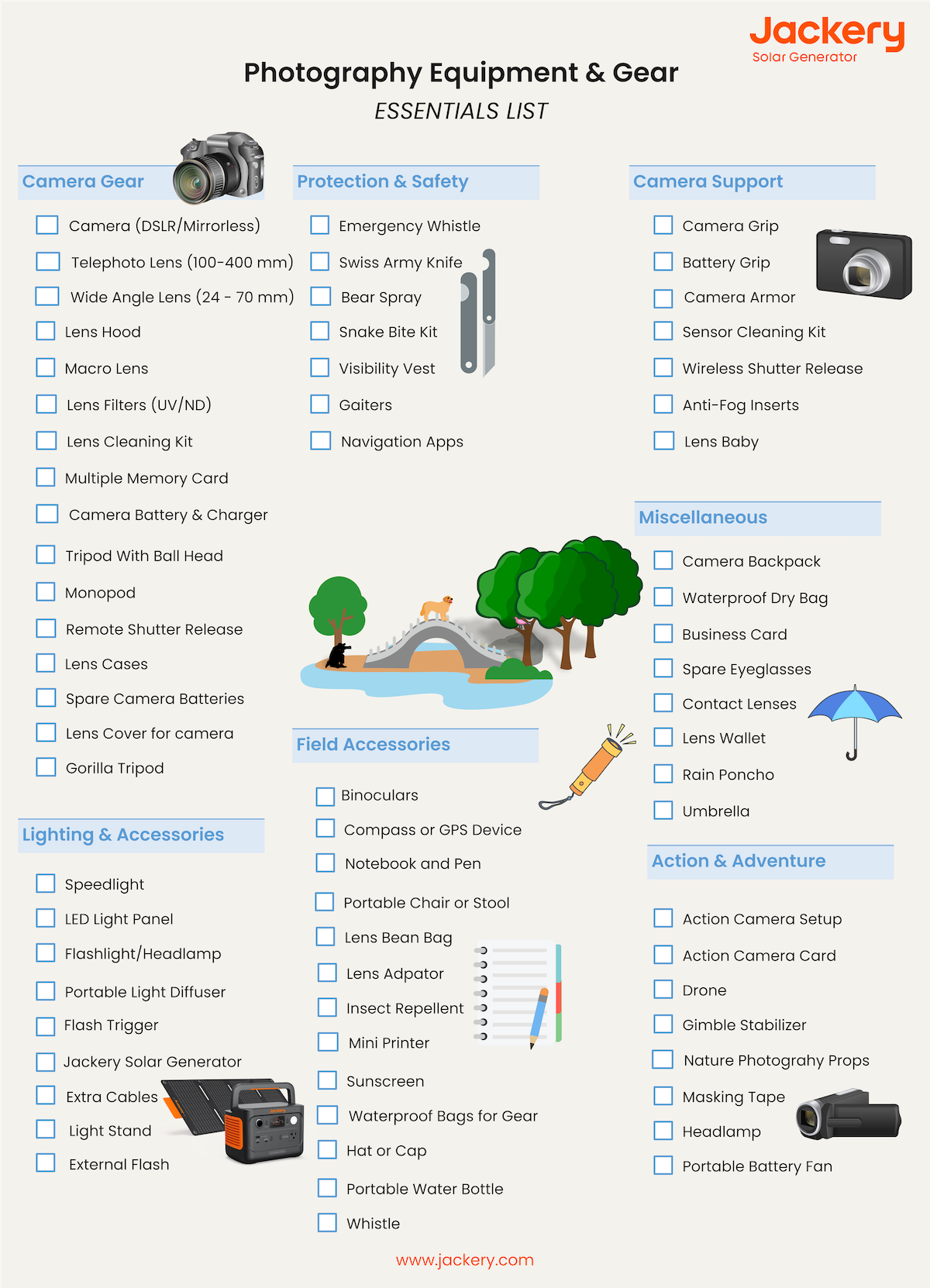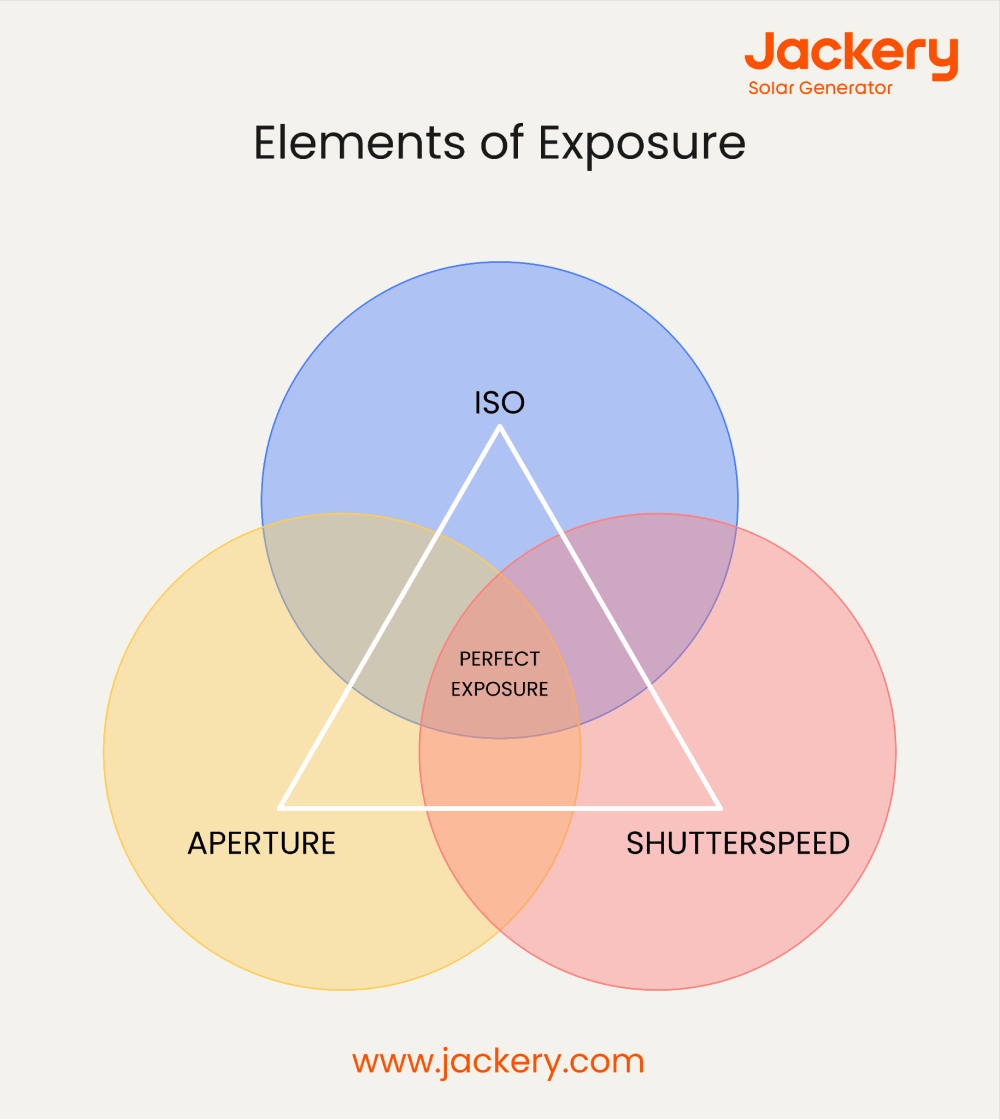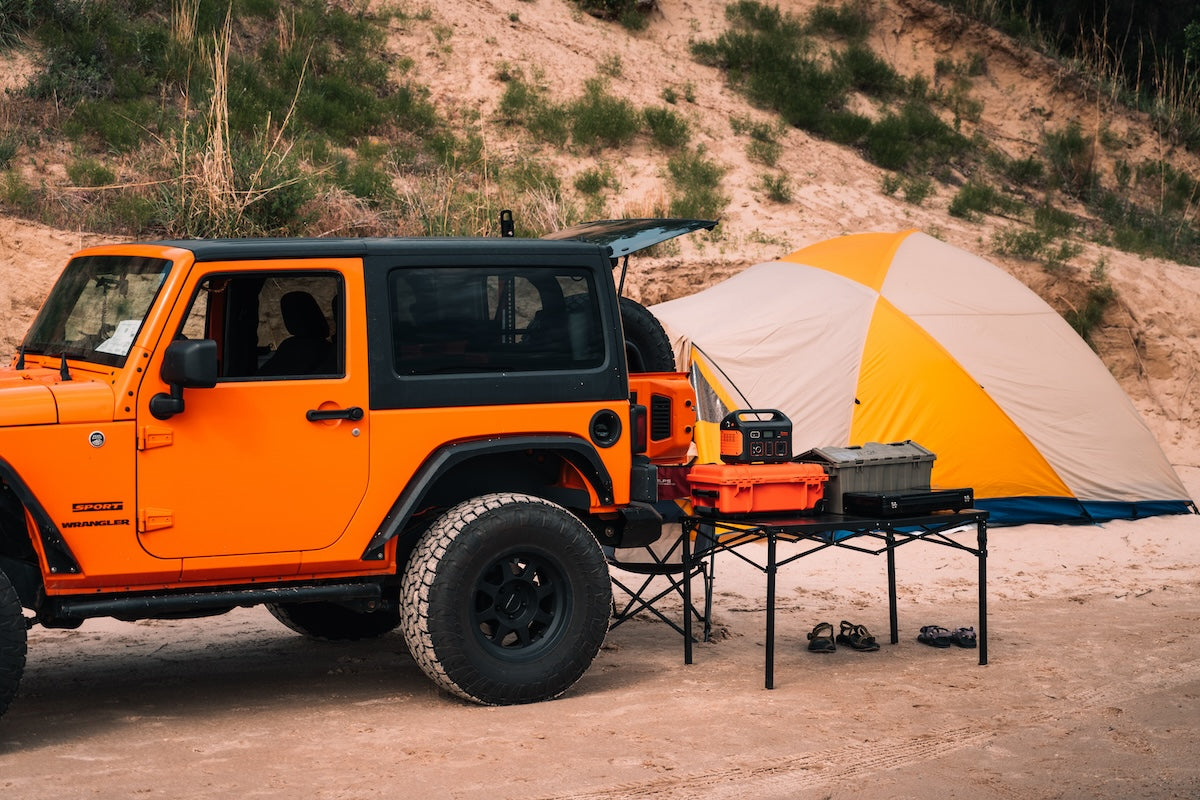Photography is one of the most talked about and loved hobbies and passions. Most hobbyists later turn it into a full-time professional. However, it becomes problematic for a few who want to start photography but find it difficult to get the latest photography tips for beginners. This art form of capturing moments can surely be converted into a full-time professional if you have followed the important tips and acquired the right knowledge at the early stage.
When learning about photography tips, the most important gear is a camera, lenses, and lights. If one is traveling to a remote location or conducting a studio shoot, then a Jackery Solar Generator is the ideal and reliable companion. The high-performance battery of the Jackery Solar Generator helps charge camera batteries and even power up the lights in the studio during extended power cuts.
What Is Photography?
The art and practice of capturing images using digital sensors is called photography. This is what taught in the early days of photography that this art form is not just about taking pictures or taking nice shots of mountains using AI-generated filters, but about capturing moments, emotions, and stories.
Photography serves as a powerful medium for self-expression and storytelling. Most journalists use photography to convey light reporting, whereas sports enthusiasts use photography gear to document events that lead to communicating ideas and visuals.
In order to understand the photography tips for beginners, one must learn different types of photography, which are:
Nature Photography
This type of photography focuses on capturing the beauty of landscapes, wildlife, plants, etc. With nature photography, a photographer can explore different colors and textures of mountains, plants, and animals.
Landscape Photography
In landscape photography, a photographer focuses more on the scenic views of the environment that includes rivers, forests, mountains, and urban skylines.
Macro Photography
It explores the intricate details of small objects or insects. Such photography requires a special camera and lens gear to capture the subject at a very close range.
Portrait Photography
In portrait photography, the focus is more on capturing the personality of individuals and groups. This typically involves controlling the lights in a way that creates a connection between the photographer and the subject.
Street Photography
Such photography helps in documenting everyday life in public spaces, where the primary focus is to capture candid moments, interactions, and scenes.
Photography Tips for Beginners: Camera Basics
While a high-end camera can offer advanced features that can help in photographing and video recording quality, it is not necessary for beginners to spend a hefty amount on an expensive camera setup. Some highly acclaimed photographers have been using entry-level DSLRs, point-and-shoot cameras, or smartphones to capture stunning images.
One of the best photography tips for beginners is to understand that what's more important than having a high-end camera is grasping the fundamentals of photography and getting clarity on camera basics.
Some of the important camera basics for beginners are:
- Focus: Always start by learning how to adjust the focus settings on a manual mode to get sharp and clear subjects.
- Zoom: Understand your camera's zoom feature to learn how to effectively bring subjects in and out of the frame.
- Flash: Try experimenting with built-in flash or strobe lights to learn how external lights affect the subject's mood.
- Exposure Compensation: Learn to adjust the exposure settings to control the darkness and brightness of your images.
- White Balance: With white balance adjustments, learn how to ensure accurate colors in varied lighting conditions.
- Shutter Speed: With varying shutter speed, learn how the shutter speed affects motion blur and how to adjust it as per the nature of your photography.
- Aperture: With aperture settings, learn the effects of it on depth of field and how to effectively control it to give creative and cinematic effects.
- ISO: With ISO, learn the camera's sensitivity to light and explore how it can tune according to different shutter speeds and apertures.
Learning about camera basics is an important photography tip for beginners, as with the right understanding of gear and equipment, a beginner can start experimenting with different shots. Some of the most common photography equipment are mentioned below:

Photography Tips for Beginners: Camera Settings
If you are shooting with a high-end mirrorless camera or are trying your hands with a compact one, it is important for beginners to familiarize themselves with the camera setting. If your camera allows you to shoot manually, then get acquainted with menu navigation, shooting modes, autofocus modes, etc., to understand how your camera functions.
Some of the most common and highly useful camera settings are:
|
Settings |
Details |
|
Shooting Mode |
A typical camera comes with different shooting modes, like Auto, Program, Aperture Priority, Shutter Priority, and Manual, to gain control over creative and exposure effects. |
|
Autofocus Mode |
By experimenting with autofocus mode, one can learn about single-shot AF, continuous AF, and manual focus. Each AF mode has different outputs and can be changed as per requirements. |
|
Lens Aperture |
Understand how the camera's aperture settings control the amount of light that enters the leaves and affects the overall depth of field. |
|
Exposure Triangle |
Explore and experiment with the relationship between aperture, shutter speed, and ISO to achieve the required exposure in various lighting conditions. |
|
ISO Setting |
With ISO settings learn how to adjust the camera's sensitivity to light, image quality, and exposure balancing. |
Tip: Whenever you acquire a new camera, try spending a few minutes checking the settings. This way, you will save time when you actually start capturing the subjects.
Photography Tips for Beginners: Photography Basics
Most photographers excel in their field because of the clarity they have when it comes to photography basics. So, the best photography tip for beginners that every seasoned photographer would give is to always start with the photography basics.
Some of the key photography basics that would get you started are:
Elements of Exposure
Exposure in the camera is determined by aperture, shutter speed, and ISO. By learning how these three elements work together, one can achieve the proper exposure that they require when they shoot in different light settings.
Rule of Thirds
In photography, the rule of thirds is the basic composition strategy where we divide the preferred frame into thirds both horizontally and vertically and place key subjects along these lines or at its intersection.
Hand-Holding Rule
Most photographers suffer from handshakes or blurry images when taking hand-held shots. So, follow the hand-holding rule, where you will ensure that the shutter speed is at least as fast as the reciprocal of your focal length.
Depth of Field
A depth of field refers to the acceptable range of distance in a scene that appears sharp in any image. This can be changed or modified by controlling the aperture and focal length.
Lighting
Try experimenting with different light sources to understand how to manipulate light when clicking fast-moving objects or shooting in extra dark spaces. Explore the natural and artificial light sources with reflectors and diffusers.

Photography Tips for Beginners: Where & How To Start
Starting a career as a professional photographer can be both exciting and scary. Whether you are passionate about capturing wildlife or documenting events and subjects from the street, there are a few important tips that you learn that would help you analyze your skills.
The first step is to understand where to start as a professional photographer. In order to understand this, you must brainstorm on what you are most passionate about when it comes to photography. Whether it is wildlife and macro or nature, portrait, street, etc., find the creative scope and start exploring it.
Some of the general photography tips for beginners are:
- Always start with your home or surroundings, as you don't need to travel exotic locations to start your professional career in photography.
- Try looking for interesting lighting, sports, textures, and backgrounds that would enhance your photos.
- Always pay attention to your subject's surroundings and simplify the composition by removing the clutter and distractions.
- Give yourself some time to learn the fundamental basics of exposure, aperture, lighting, and composition.
- Remember to take your camera every day so you can master different tips and tricks.
- Try sharing your photographs with your peers or professional photographers to get their constructive criticism on improving your work.
- Try surrounding yourself with inspiration from various sources, including photography books, magazines, documentaries, social media pages, and other seasoned photographers.
- Step out of your comfort zone to try new locations, techniques, and genres of photography, as this will help you improve your creative process.
- Always be patient and persistent with this art form, and give yourself ample amounts of practice every day to master the shots, techniques, and camera settings.
- There is always something new in the world of photography, so keep yourself on top of everything by learning new methods.
Some of the more professional photography tips for beginners are:
Nature Photography
- Before going on a natural photography shoot, research the area to understand its natural features and potential subjects.
- During natural photography, try taking advantage of the soft, golden light during the sunrise and sunset for the most flattering nature shots.
- Nature photography requires the understanding of ISO, aperture, shutter speed, and the usage of the right lens. Before heading out for the extensive shoots, get yourself acquainted with these camera basics.
Portrait Photography
- When planning a portrait shoot, try building a good rapport with your subject to capture engaging portraits. Let your models get accustomed to lighting and studio setups.
- Consider different lighting setups to flatter your model's features and convey the desired effect and emotion.
- Try different posing, framing, and background elements to create a visually appealing portrait that would convey the meaning of the shot.
- Use different focal lengths to achieve varying compositions in your portraits. You can even use wide-angle lenses to add context and depth to your pictures.
Macro Photography
- Shoot macro objects with a macro lens or extension tubes to get the intricate details and textures that might not get recorded on a prime lens.
- Invest in a good tripod or a monopod to stabilize your camera and get sharp, detailed pictures.
- When shooting small objects, like flowers or insects, use a narrow aperture to increase the depth of field to ensure that your subject remains in focus, and does not have blurry outlines.
How do Jackery Solar Generators Help with Photography?
Jackery is an award-winning global brand that manufactures a line of portable solar generators, power stations, and solar panels. The high-performance batteries of Jackery Solar Generators are perfect for outdoor photoshoots where there is no direct power supply or even for indoor shoots during extended power cuts.
The Jackery Solar Generators come with an intelligent BMS system and pure sine wave inverter that provides 12 layers of protection to charging devices. Due to its portable nature and lightweight, Jackery Solar Generators are ideal for those who prefer lower noise generators that provide environmentally friendly forms of clean energy. Furthermore, when plugged in with Jackery SolarSaga Solar Panels, these Jackery Solar Generators provide clean energy to power up or charge photography gear and important equipment.
Jackery Solar Generator 500
The Jackery Solar Generator 500 is ideal for beginners and seasoned photographers who have multiple devices that need powering up when they are shooting. This solar generator features three USB ports, an AC outlet, and 12 V car output to convert solar energy to provide pure sine wave power to power photography gear, like lights, smartphones, camera batteries, laptops, etc.
In order to understand the working hours, let's take a scenario where you need to charge a power flash (70 W), laptop (70 W), and a camera battery (5 W) with Jackery Solar Generator 500:
Working Hours = Battery Capacity in Wh * 0.85 / Wattage Consumption of All the Appliances
Working Hours = 518 Wh * 0.85 / 145 W = 3.03 H
Note: The reason to multiply it with 0.85 is because of some power loss while charging the appliances.

Customer Review:
"Charging my phone while camping on a box that was powered by the sun…that rocks." -- Kimberly.
Jackery Solar Generator 300 Plus
If you are looking for a lightweight and portable solar generator with solar panels that can be added to your backpack, the Jackery Solar Generator 300 Plus is an excellent choice. The Jackery Solar Generator 300 Plus boosts a 288 Wh battery capacity and has a noise level of less than 45 dB, which is ideal for long remote shoots. Jackery Solar Generator 300 Plus is capable of fast charging multiple camera gear and equipment simultaneously and offers various charging options for easy-to-setup outdoor charging.
In order to understand the working hours, let's take a scenario where you need to charge a laptop (70 W), LED lights (60 W), and a camera battery (5 W) with Jackery Solar Generator 300 Plus:
Working Hours = Battery Capacity in Wh * 0.85 / Wattage Consumption of All the Appliances
Working Hours = 288 Wh * 0.85 / 135 W = 1.8 H

Customer Review:
"Very useful for camping and emergency backup for small electronics in power outages." - Chris.
Photography Tips for Beginners FAQs
What size of solar generator do I need for photography?
The size of a solar generator that is sufficient for remote and studio photography depends on the number of camera gear you would like to power simultaneously.
Let's consider the fact that you need to power up your camera battery (5 W), LED lights (60 W), and smartphone (20 W) with a Jackery Solar Generator 500:
Working Hours = Battery Capacity in Wh * 0.85 / Wattage Consumption of All the Appliances
Working Hours = 518 Wh * 0.85 / 85 W = 5.1 H
How should a beginner practice photography?
The best photography tip for beginners to practice is to master the basics like camera settings and compositions. With regular practice and experimenting with exposure triangles, one can improve their overall skills.
What is the 3-1 rule in photography?
A 3-1 rule in photography divides the frame into thirds horizontally and vertically, where it places the main subject at intersection points that create a balanced composition.
What are the 7 basics of photography?
The most important 7 basics of photography are mastering exposure, learning composition techniques, focal length, white balance, lighting, focusing, and post-processing.
Can I self-teach myself photography?
Yes, you can easily teach yourself photography by checking online resources. Beginners can start by learning the basics of camera, lens, and lighting. Additionally, regular practice and seeking feedback from professionals can enhance photography skills in no time.
Final Thoughts
From learning about camera settings and lights to mastering exposure triangle, rule of thirds, depth of fields, etc, there are several creative photography tips for beginners. By following these tips and regular practice, one can upscale themselves and start their career as a professional photographer.
There are several important camera gear and equipment that make the process for a photographer, and among them is Jackery Solar Generators. These solar generators are portable and extremely lightweight, which makes them ideal to be carried around in remote locations for nature or wildlife photography. Apart from charging your camera gear, these portable power stations can even charge your camping equipment or power up your photo studios during extended power cuts.
Learning Resources
Books
Beginner's Photography Guide 2nd Edition: The Ultimate Step-by-Step Manual for Getting the Most from your Digital Camera by DK
Getting Started With DSLR Photography: A Beginner's Guide to Capturing Beautiful Photos With Your Digital Camera by Kevin Jobson
Beginner's Photography Book: An introduction to digital photography and related terminology by Keith Silvas
The School of Photography: Beginner's Guide: Master your camera, clear up confusion, create stunning imagery by Marc Newton
The Beginners Photography Book for Kids: Learn How to Take Amazing Photos by J.P. Pullos





















































































































Leave a comment